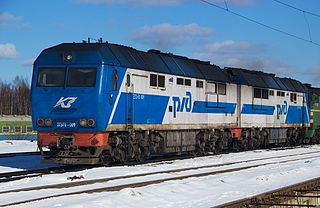
The M62 is a Soviet-built diesel locomotive for heavy freight trains, exported to many Eastern Bloc countries as well as to Cuba, North Korea and Mongolia. Beside the single locomotive M62 also twin versions 2M62 and three-section versions 3M62 have been built. A total number of 7,164 single sections have been produced, which have been used to build 5,231 single-, twin- and three-section locomotives.

Broad Gauge Metallurgy Line is the longest broad gauge railway line in Poland.

Varshavsky station, or Warsaw station, is a former passenger railway station in Saint Petersburg, Russia. It is located to the south of the city centre, and was in operation from 1853 to 2001 From 2001 to 2017 it served as the home of the Russian Railway Museum.

The Soviet locomotive class IS was a Soviet passenger steam locomotive type named after Joseph Stalin. The contract design was prepared in 1929 at V.V. Kuybyshev Locomotive Factory in Kolomna, Russian SFSR. The IS series locomotives were manufactured between 1932 and 1942. The last one was built in 1942 during the Great Patriotic War against Nazi Germany.

TU2 (ТУ2) is a Soviet narrow gauge diesel locomotive for the track gauge of 750 mm

The Soviet Union was heavily dependent on rail transport, not least during the Russian Civil War and World War II, but also for industrialization according to the five-year plans.

The Russian locomotive class O was an early type of Russian steam locomotives. 9,129 locomotives were built between 1890 and 1928; hence it was the second most numerous class of locomotive in Russia, after E class, which was a unique number even on the international level.

The Soviet locomotive class FD was a Soviet main freight steam locomotive type named after Felix Dzerzhinsky. Between 1932 and 1942, 3213 FD series locomotives were built.

Electric locomotive EP1 is a Russian electric locomotive which has been produced by Novocherkassk Electric Locomotive Plant since 1998. It is the first Russian passenger electric locomotive with the 2o-2o-2o or Bo-Bo-Bo axle arrangement. There are, as December 2016, 866 of these locomotives.

TE10 is a diesel-electric locomotive from the Soviet Union. The name of this locomotive (ТЭ10) is from тепловоз с электрической передачей, тип 10, which translates to "diesel-electric locomotive type 10."

The ChS4 is an electric mainline AC passenger locomotive used in Russia, Belarus, and Ukraine.

The ChS7 is an electric mainline DC passenger locomotive used in Russia and Ukraine. The locomotive consists of two sections and was produced in years 1983 to 1999 at Škoda's V.I. Lenin plant in Plzeň, Czech Republic. It was specially developed for the railways of Soviet Union with later models procured by Russian and Ukrainian operators. Along with ChS8, the Chs7 is one of the most powerful electric locomotives used in the countries of the former USSR.

The ChS2 Russian: ЧС2 is an electric mainline DC passenger locomotive used in Russia and Ukraine. It was manufactured by the Škoda Works in Czechoslovakia between 1958 and 1973.

The VL11 Russian: ВЛ11 is an electric mainline DC freight and passenger locomotive, built in Georgia, used in Russia and Ukraine. The initials VL are those of Vladimir Lenin, after whom the class is named.

ED4 are a series of Russian electric trainsets, in production since 1996. The trains are produced by DMZ and currently in service on RZD lines in almost every part of the country and former USSR states.

The TEP70 is a main line single-unit diesel locomotive, rated at 2,964 kW (3,975 hp), with AC/DC transmission and individual axle traction control, designed to haul passenger trains on the Russian gauge railway network of eastern Europe. As of 2022, it is still in service in Russia, Ukraine, Belarus, Estonia, Latvia, Lithuania, and Kazakhstan. It is the successor to the TEP60, with many design elements is derived from that locomotive; however, the engine was replaced by a four-stroke one. TEP70, especially its experimental batch, incorporated some features of British Rail HS4000, for example, its bogies and some elements of driving control equipment. Later batches of this locomotive incorporated some design features from TEP75 experimental locomotive and predecessor TEP70. Final batches, produced until 2006, also had several important improvements.

The 2TE70 is a Russian main line dual unit freight diesel locomotive, rated at 5,884 kW (7,891 hp). It has AC/DC transmission and individual axle traction control and is designed to haul freight trains on the Russian Federation lines RŽD with 1,520 mmRussian gauge. The 2ТE70 Freight diesel locomotive with two six-axle sections shares main parts with the TEP70 and TEP70BS passenger diesel locomotives. Each section is rated at 2,964 kW (3,975 hp) and it is designed for running freight trains of up to 6,000 t.

The 2TE25K is a main line two-unit diesel-electric locomotive, rated at 5,000 kW (6,705 hp). It is equipped with AC/DC transmission and is designed to haul freight trains on the Russian Federation lines RZD on the broad gauge.

The ChS3 is a type of 4-axle passenger direct current electric locomotive, manufactured in 1961, which was used in the Soviet Union and the Russian Federation. In 1960, due to the increase in passenger trains, the Skoda factory was ordered to design and produce a more powerful locomotive type than the ChS1. The plant's management decided to base the new electric locomotives on the ChS1 class of locomotive. Therefore, the more powerful AL4846eT traction motors and traction drive were installed in the experimental ChS1 locomotive. Thus, the ChS3 design was an improved version of the ChS1.

The Soviet locomotive class LV was a Soviet main freight steam locomotive type. Between 1952 and 1956, 522 locomotives were built.




















